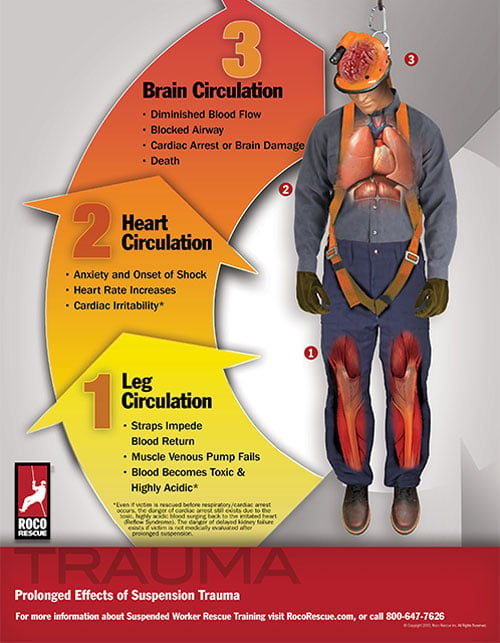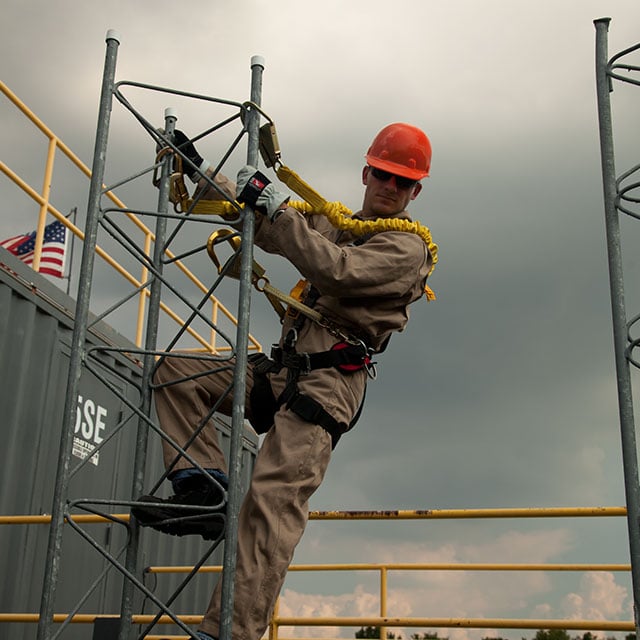 What exactly is suspension trauma? How does it occur? And what can be done to prevent it?
What exactly is suspension trauma? How does it occur? And what can be done to prevent it?
Suspension Trauma - otherwise known as harness pathology, distributive shock, or orthostatic intolerance - has recently been identified by OSHA as a workplace hazard particular to Authorized Workers using personal fall arrest systems (PFAS). More and more employers are becoming aware of this workplace hazard and are taking appropriate steps to protect their employees. The range of understanding on the cause of the hazard, as well as how to protect against it, is pretty vast.
Our new Suspension Trauma Safety Poster is a tool to raise awareness of this hazard. It illustrates the pathological path that a fallen suspended worker may experience. Please share with colleagues, fellow safety professionals and especially workers that use PFAS. It could save a life.
The rate at which suspension trauma develops varies from individual to individual and is not reliably predictable. However, there are factors that influence the potential for suspension trauma as well as the speed of onset. Here are a few examples:
- Underlying physical condition of worker including any pre-existing respiratory or cardiac conditions;
- Worker’s ability to handle stress and anxiety;
- Harness selection, fit, and adjustment;
- Traumatic injuries that may have occurred during or before the fall; and,
- Knowledge and the use of equipment or techniques to delay the onset of suspension trauma such as temporary leg stirrups or simply “bicycling the legs.”
Roco also offers a course called Rescue From Fall Protection to educate rescuers who respond to suspended workers.

Pathological Effects of a Fallen Worker in Danger of Suspension Trauma
For those of you who prefer a more detailed explanation, here's the narrative from Roco Chief Pat Furr.
1. Leg Circulation: A fall arrest harness does a great job of dissipating the energies generated during a fall arrest through the long axis of the human body. After all motion has stopped, that same harness – particularly the dorsal attachment configuration – will most likely impose pressure to the femoral vein, which is the primary blood vessel that returns blood from the legs towards the heart. In fact, in order to pass certification testing, these harnesses must not allow the test mannequin to assume greater than a 30 degree forward lean upon suspension. Any degree of forward lean will exert leg strap pressure on the femoral vein which impedes blood return. To compound this, the human body relies on what is known as the muscle/venous pump to assist the blood return from the legs to the heart. In suspension, the worker often forgets to bicycle their legs to create this muscle/venous pump. The trapped blood in the legs creates what is known as distributive shock as more and more blood is trapped in the legs; there is less to circulate for the rest of the body (brain, heart, lungs, and kidneys). Additionally, this blood becomes highly acidic and toxic with metabolic wastes.
 2. Heart Circulation: As the body goes into distributive shock, the heart must increase the rate and strength of its contractions to compensate. To compound this, the suspended worker may be experiencing a high degree of fear and anxiety, which releases adrenalin into the bloodstream which also causes the heart to work harder and faster. This places increased demands on the heart, which is receiving less blood flow and thus less oxygen. The heart becomes irritable and is prone to localized tissue damage, dysrhythmias or both. This is especially a concern once the worker is rescued and the toxic blood is allowed to surge from the legs to the irritable heart. This is known as reflow syndrome and has caused several victims to go into sudden cardiac arrest upon rescue.
2. Heart Circulation: As the body goes into distributive shock, the heart must increase the rate and strength of its contractions to compensate. To compound this, the suspended worker may be experiencing a high degree of fear and anxiety, which releases adrenalin into the bloodstream which also causes the heart to work harder and faster. This places increased demands on the heart, which is receiving less blood flow and thus less oxygen. The heart becomes irritable and is prone to localized tissue damage, dysrhythmias or both. This is especially a concern once the worker is rescued and the toxic blood is allowed to surge from the legs to the irritable heart. This is known as reflow syndrome and has caused several victims to go into sudden cardiac arrest upon rescue.3. Brain Circulation: As the victim goes into distributive shock, or worst case, suffers cardiac arrest, the brain is deprived of adequate blood supply and this can lead to unconsciousness. If the victim faints the airway can be blocked by the head position or even by a poorly adjusted harness that allows the chest strap to block the airway. That is a difficult statement to write into a fatality report “Cause of Death: Strangulation by Victim’s Own PPE.” If the victim’s heart stops, we can expect permanent brain damage or death in as little as four minutes.
So it should be obvious that a prompt rescue capability must be ensured by any employer that has Authorized Persons using PFAS. This can be accomplished in many ways. Roco has a variety of training courses that are specifically designed to provide that prompt rescue capability for fallen/suspended workers.
We also worked with CMC to design a new harness to protect suspended workers from suspension trauma.
For more information please contact Roco Rescue at 800-647-7626 or submit a question to our Tech Panel.


 To maintain their service life and high performance, all belts and harnesses should be inspected frequently. Visual inspection before each use should become routine, and also a routine inspection by a competent person. If any of the conditions listed below are found, the equipment should be replaced before being used.
To maintain their service life and high performance, all belts and harnesses should be inspected frequently. Visual inspection before each use should become routine, and also a routine inspection by a competent person. If any of the conditions listed below are found, the equipment should be replaced before being used. Pat Furr reviews the importance of following OSHA safety standards for fall protection, and the steps an employer can take to ensure a safe work environment by providing high quality training. In the recent article by Mark Stromme, published in ISHN and on this blog, he addresses several myths regarding compliance with OSHA Fall Protection in the construction industry. Fact is, this wisdom applies to industry across the board.
Pat Furr reviews the importance of following OSHA safety standards for fall protection, and the steps an employer can take to ensure a safe work environment by providing high quality training. In the recent article by Mark Stromme, published in ISHN and on this blog, he addresses several myths regarding compliance with OSHA Fall Protection in the construction industry. Fact is, this wisdom applies to industry across the board.  One of the most important steps an employer can take towards developing an effective comprehensive fall protection program is to provide top quality training to their selected fall protection competent persons. By selecting the right person(s) for this position, the employer is assigning a degree of authority and expectations that the competent person will be very well versed in all there is to know about fall protection.
One of the most important steps an employer can take towards developing an effective comprehensive fall protection program is to provide top quality training to their selected fall protection competent persons. By selecting the right person(s) for this position, the employer is assigning a degree of authority and expectations that the competent person will be very well versed in all there is to know about fall protection. Fall protection must be provided when employees are performing construction work on a walking/working surface with an unprotected side or edge that is six feet or more above a lower level. (Note: Construction work is “work for construction, alteration, and/or repair, including painting and decorating.”)
Fall protection must be provided when employees are performing construction work on a walking/working surface with an unprotected side or edge that is six feet or more above a lower level. (Note: Construction work is “work for construction, alteration, and/or repair, including painting and decorating.”) It is becoming more and more difficult to find a hilltop or a ridge in America that does not have some type of telecom tower placed on it. Likewise, there are many other types of towers popping up across the countryside and in our urban and suburban areas. Everything from wind turbine towers to high tension transmission line towers.
It is becoming more and more difficult to find a hilltop or a ridge in America that does not have some type of telecom tower placed on it. Likewise, there are many other types of towers popping up across the countryside and in our urban and suburban areas. Everything from wind turbine towers to high tension transmission line towers.

 and incident encountered. A second way is to use pre-built systems in an attempt to cover all situations. Both approaches have their advantages and disadvantages. Generally, build-as-you-go systems require marginally more initial training and may not have the same degree of skill retention as pre-built systems. But their advantage is the system can be tailored to fit the situation more readily and the components of the system can also be used for planned work activities. Pre-built systems have a slightly higher rate of skill retention and are ready to be employed as soon as they are put into service. They are, however, limited to a specific function and are not typically used for any other purpose other than for rescue. These pre-built systems are typically packaged in a protective pouch and can be fairly bulky. Thus, they’re typically left at ground level and must be retrieved before a rescue can commence.
and incident encountered. A second way is to use pre-built systems in an attempt to cover all situations. Both approaches have their advantages and disadvantages. Generally, build-as-you-go systems require marginally more initial training and may not have the same degree of skill retention as pre-built systems. But their advantage is the system can be tailored to fit the situation more readily and the components of the system can also be used for planned work activities. Pre-built systems have a slightly higher rate of skill retention and are ready to be employed as soon as they are put into service. They are, however, limited to a specific function and are not typically used for any other purpose other than for rescue. These pre-built systems are typically packaged in a protective pouch and can be fairly bulky. Thus, they’re typically left at ground level and must be retrieved before a rescue can commence. Whatever means you decide on to provide a tower rescue capability, as either a tower worker or as part of an emergency response team, it is absolutely imperative that you adhere to safe work practices while climbing by always using 100% fall protection. Seek out and attend professional tower rescue training; and, finally, ensure that the tower climbing/rescue equipment is in serviceable condition and is ready and available to be employed. For those of you in deer and elk country, be especially diligent to ensure that your pre-built system is where it’s supposed to be when hunting season comes around. Not only are they great for rescue, but they come in handy at the hunting camp also.
Whatever means you decide on to provide a tower rescue capability, as either a tower worker or as part of an emergency response team, it is absolutely imperative that you adhere to safe work practices while climbing by always using 100% fall protection. Seek out and attend professional tower rescue training; and, finally, ensure that the tower climbing/rescue equipment is in serviceable condition and is ready and available to be employed. For those of you in deer and elk country, be especially diligent to ensure that your pre-built system is where it’s supposed to be when hunting season comes around. Not only are they great for rescue, but they come in handy at the hunting camp also.


